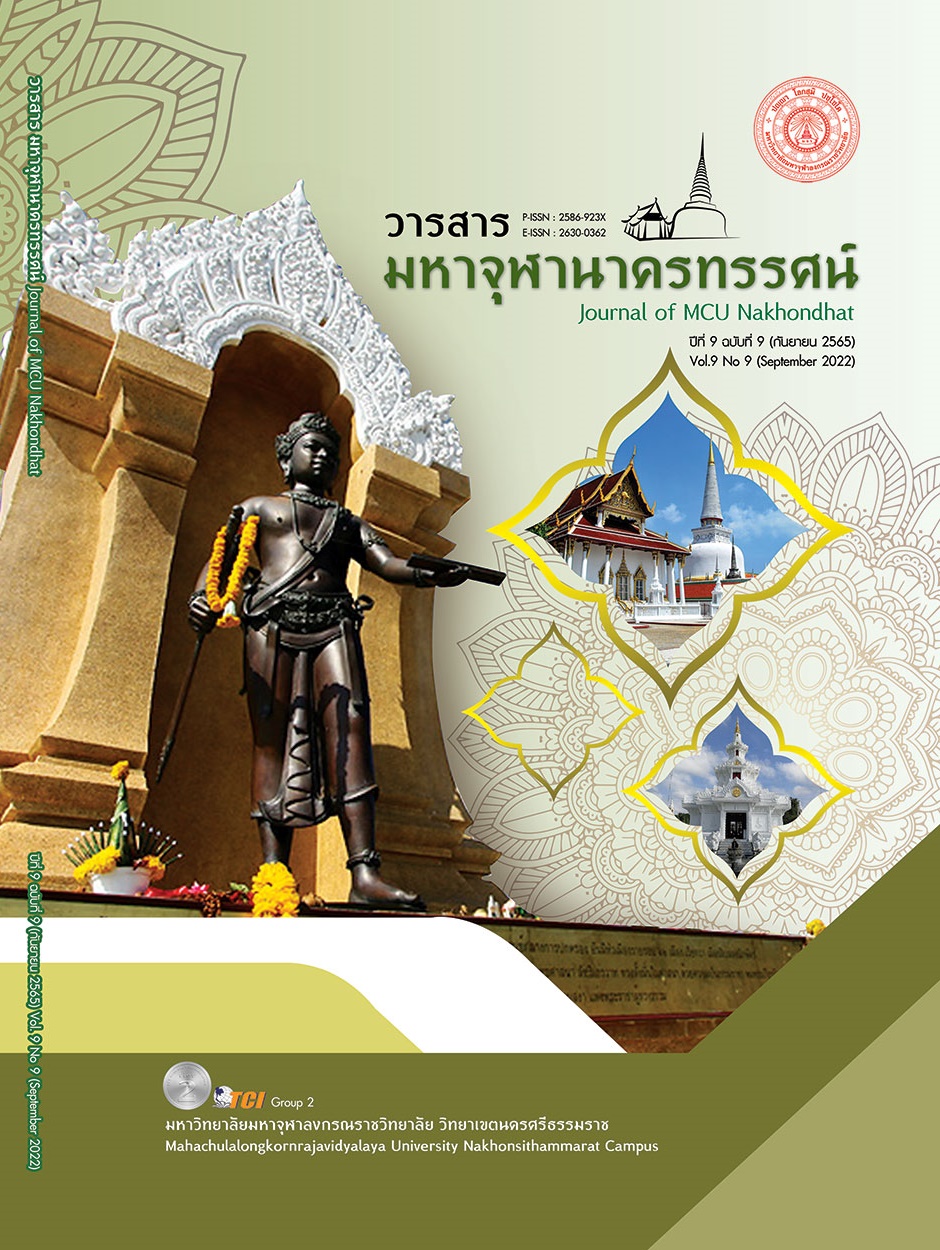การพัฒนารูปแบบการเรียนการสอนโดยบูรณาการทฤษฎีประมวลสารสนเทศและการเรียนรู้เชิงสถานการณ์ที่ส่งเสริมสมรรถนะการสื่อสาร ด้านการฟังและการพูดภาษาเวียดนามสำหรับนักศึกษาระดับปริญญาตรี
Main Article Content
บทคัดย่อ
บทความวิจัยครั้งนี้มีวัตถุประสงค์เพื่อ 1) ศึกษาข้อมูลพื้นฐานเพื่อพัฒนารูปแบบการเรียนการสอนที่ส่งเสริมสมรรถนะการสื่อสารด้านการฟังและการพูดภาษาเวียดนาม 2) พัฒนารูปแบบการเรียนการสอนโดยบูรณาการทฤษฎีประมวลสารสนเทศและการเรียนรู้เชิงสถานการณ์ที่ส่งเสริมสมรรถนะการสื่อสารด้านการฟังและการพูดภาษาเวียดนาม กลุ่มตัวอย่างที่ใช้ในการวิจัยเป็นผู้สอนภาษาเวียดนามในระดับปริญญาตรีจำนวน 10 คน วิธีการเลือกกลุ่มตัวอย่างแบบเจาะจง เครื่องมือที่ใช้ในการวิจัย 1) แบบสัมภาษณ์เชิงลึกสำหรับผู้สอนภาษาเวียดนาม 2) แบบประเมินคุณภาพของกรอบสมรรถนะการสื่อสารด้านการฟังและการพูดภาษาเวียดนาม 3) รูปแบบการเรียนการสอน และ 4) แบบประเมินคุณภาพของรูปแบบการเรียนการสอน ใช้การวิเคราะห์ข้อมูลโดยวิธีการวิเคราะห์เนื้อหาประกอบด้วยสถิติเชิงบรรยาย ได้แก่ ค่าเฉลี่ยและส่วนเบี่ยงเบนมาตรฐาน ผลการวิจัยพบว่า 1) ข้อมูลพื้นฐานเพื่อพัฒนารูปแบบการเรียนการสอนที่ส่งเสริมสมรรถนะการสื่อสารด้านการฟังและการพูดภาษาเวียดนามมี 4 ส่วน ได้แก่ 1. สภาพการจัดการเรียนการสอน 2. ปัญหาในการจัดการเรียนการสอน 3. สาเหตุที่ทำให้เกิดปัญหาในการจัดการเรียนการสอน และ 4. ปัจจัยที่ส่งเสริมและพัฒนาในการจัดการเรียนการสอน และผลการประเมินคุณภาพของกรอบสมรรถนะการสื่อสารด้านการฟังและการพูดภาษาเวียดนามโดยรวมอยู่ในระดับมากที่สุด 2) การพัฒนารูปแบบการเรียนการสอนโดยบูรณาการทฤษฎีประมวลสารสนเทศและการเรียนรู้เชิงสถานการณ์ที่ส่งเสริมสมรรถนะการสื่อสารด้านการฟังและการพูดภาษาเวียดนาม ประกอบด้วย 8 องค์ประกอบและผลการประเมินคุณภาพของรูปแบบการเรียนการสอนโดยรวมมีความเหมาะสมอยู่ในระดับมากที่สุด
Article Details

อนุญาตภายใต้เงื่อนไข Creative Commons Attribution-NonCommercial-NoDerivatives 4.0 International License.
เอกสารอ้างอิง
ฉัตรณรงค์ศักดิ์ สุธรรมดี และ จินตการด์ สุธรรมดี. (2560). การประยุกต์ใช้สมรรถนะเพื่อพัฒนาทัพยากรณ์-มนุษย์. วารสารมหาวิทยาลัยราชภัฏร้อยเอ็ด, 11(1), 262-269.
ทิศนา แขมมณี. (2550). รูปแบบการเรียนการสอน: ทางเลือกที่หลากหลาย. (พิมพ์ครั้งที่ 4). กรุงเทพมหานคร: สำนักพิมพ์แห่งจุฬาลงกรณ์มหาวิทยาลัย.
นุจรีย์ สุทธิพันธ์. (2017). ปัจจัยที่มีผลต่อการฟังภาษาจีนของนักศึกษาหลักสูตรภาษาจีน มหาวิทยาลัยวลัย-ลักษณ์ กรณีศึกษานักศึกษาที่เข้าร่วมโครงการ In Country Study Program ประจำปีการศึกษา 2560. ใน รายงานการประชุมหาดใหญ่วิชาการระดับชาติและนานาชาติครั้งที่ 10. 223 -238.
รุ่งพนอ รักอยู่. (2017). ความสามารถด้านการฟังภาษาอังกฤษเพื่อความเข้าใจของนักศึกษาไทยที่เรียนภาษาอังกฤษเป็นภาษาต่างประเทศในสถาบันการพลศึกษาในเขตภาคกลาง. วารสารชุมชนวิจัย, 13(3), 81-94.
ฤทัยรัตน์ ศรีพวงมาลัย. (2561). การศึกษาผลสัมฤทธิ์ด้านการฟังภาษาอังกฤษเพื่อความเข้าใจโดยการจัดการเรียนรู้ผ่านพอดคาสต์ของนักเรียนชั้นประถมศึกษาปีที่ 6 โรงเรียนหนองกุงศาลาน้ำเที่ยงวิทยากร. ใน วิทยานิพนธ์ศึกษาศาสตรมหาบัณฑิต สาขาวิชาการสอนภาษาอังกฤษ ภาควิชาหลักสูตรและการสอน. มหาวิทยาลัยศิลปกร.
เหงียน ถิ ทู แถ่น. (2563). การจัดการเรียนรู้แบบตอบสนองด้วยท่าทางเพื่พัมนาความสามารถด้านการฟังและการพูดภาษาเวียดนามของนักเรียนชั้นประถมศึกษาปีที่ 1 โรงเรียนสาธิต มหาวิทยาลัยราชภัฏวไลย-อลงกรณ์ ในพระบรมราชูปถัมภ์. ใน วิทยานิพนธ์ครุศาสตรมหาบัณฑิต สาขาวิชาหลักสูตรและการสอน. มหาวิทยาลัยราชภัฏวไลยอลงกรณ์ ในพระบรมราชูปถัมภ์.
เหงียน ถิ เหลียว. (2563). การศึกษาความสามารถในการสื่อสารภาษาเวียดนามเบื้องต้นโดยการจัดการเรียนรู้แบบร่วมมือเทคนิค STAD ประกอบเกมทางภาษาของนักเรียนชั้นมัธยมศึกษาปีที่ 2 โรงเรียนสาธิต มหาวิทยาลัยราชภัฏวไลยอลงกรณ์. ใน วิทยานิพนธ์ครุศาสตรมหาบัณฑิต สาขาวิชาหลักสูรและการสอน. มหาวิทยาลัยราชภัฏวไลยอลงกรณ์ ในพระบรมราชูปถัมภ์.
Bachman, L. F. & Palmer, A. S. (1982). The Construct validation of some components of communicative proficiency. TESOL Quarterly, 16(4), 449-465.
Canale, M. & Swain, M. (1980). Theoretical Bases of Communicative Approaches to Second Language Teaching and Testing. Applied Linguistics, 1 (1), 1-47.
Cu, T.M.N. (2017). Difficulties in practicing Vietnamese outside classroom of Korean’s students at Faculty of Vietnamese Studies, University of Social Science and Humanity, Vietnam National University Ho Chi Minh city. In Proceeding of National Academic Conference: Researching, Teaching Vietnameses studies and Vietnamese: Theoretical and Pratical Problem (pp. 219-226).
Harmer, J. (2007). How to teach English (2nd ed.). Harlow: Pearson Education Limited.
Nguyen, T.H.V. & Nguyen, T.H. (2018). Teaching Vietnamese as the Second Foreign Language – Building and Using the Lesson Vietnamese Teaching Model and Exercise Type. tional Research, 6 (5), 519-525.
OECD. (2003). Key competencies for a successful life and well- functioning society. In The definition and selection of key competencies. Executive summary.
Oxford, R. (1990). Language learning strategies: What every teacher should know. New York: Newbury House Publishers.
Savignon, S. J. (1983). Communicative Competence: Theory and Classroom Practice. Reading, MA: Addison -Wesley Publishing Company.
Spencer, L. M. JR. & Spencer, S. M. (1993). Competence at Work: Model for Superior Performance. New York: John Wiley & Sons.
Stern, H. H. (1975). “What can we learn from the good language learner?”. Canadian Modern Language Review, 31 (4), 304-318.
Vikram, S. C. & Sandeep, S. (2014). Understanding Competencies and Competency Modeling - A Literature Survey. IOSR Journal of Business and Management , 16(1), 14-22.


